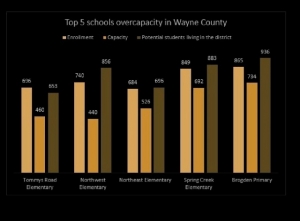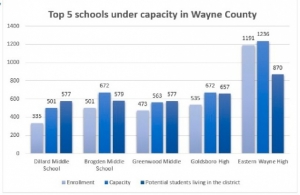A closer look at the need for redistricting
By Joey Pitchford
Published in News on August 13, 2017 1:45 AM
Student transfers, residential development and state legislation are all factors Wayne County Public Schools officials must now consider as the system begins to work on redistricting.
Its main goal is to help solve the substantial overcrowding impacting many Wayne County schools by redistributing students among them.
The overcrowding is especially prevalent in elementary schools -- 11 of 13 elementary schools were overcrowded during the 2016-17 school year, according to a presentation given by WCPS Assistant Superintendent David Lewis in April.
The top five most overcrowded schools in 2016-17 were all elementary schools. Northwest Elementary, the most overcrowded, had an enrollment of 740 students on March 6, 2017, compared to a recommended maximum capacity of 440.
Tommy's Road Elementary, where the Wayne County Board of Education recently voted to spend more than $300,000 to install mobile units, was 236 students over capacity in March.
The state does not factor in mobile classrooms when determining a school's capacity, as the number is supposed to reflect the facility as built.
As students move up from elementary school, the numbers paint a much different picture. At the middle school level, four of nine schools were overcrowded in March, with the most crowded school being Norwayne Middle at 126 students over capacity.
Area high schools, meanwhile, are significantly undercapacity. Not a single high school was overcrowded as of March, and both Goldsboro High and Eastern Wayne High were more than 100 students under capacity.
Lewis said that he was not sure why elementary schools have been so much more crowded than other school levels.
"Our overall enrollment has actually gone down, so I don't know the answer to that question," he said. "That is one of the things we're working on figuring out as part of this process."
Are Student Transfers to Blame?
Parents and community members have often looked to the school system's relatively open student transfer policy to explain how some schools have become so crowded.
In previous years, school administrators approved transfer requests -- even to schools which were already over capacity -- despite the practice being against board policy. That ended this year after the board voted to strictly enforce the rules as written, thereby blocking any future transfers to over-capacity schools.
But that might only stem the problem, it won't solve it.
Sending every single transfer student back to their base school would not substantially impact overcrowding. In fact, the problem would worsen at many schools.
For instance, 128 students transferred out of Northwest in 2016-17, while only 12 transferred in. If those students had each been forced back to their base schools, Northwest would have gone from 300 students over capacity, to 416.
Of the top five most overcrowded schools, only Tommy's Road would see a reduction in student population if all transfers were revoked. Even then, the school would still be nearly 200 students over capacity.
Most of the schools that would gain a meaningful amount of space from moving transfer students are already less crowded than other schools.
Fremont STARS -- currently 40 students under capacity -- would jump to 104 free spaces. Meadow Lane Elementary's 2016-17 enrollment was comprised by more than one-third of transfer students. If reversed, the school would go from 21 students over capacity to 177 under.
And the opposite would happen in schools where many students have transfered out. Dillard Middle had by far the most transfers out of any school in 2016-17, with 244 students leaving and only two coming in. Reassigning all transfer students would take Dillard from 166 students under capacity to 76 over.
Only Goldsboro High, with 128 transfers out in 2016-17, would go from 137 unoccupied spaces to 15, much closer to being at capacity.
A Shifting Population.
The issue, Lewis said, has more to do with population growth than unchecked student transfers. Many of the most crowded schools are in the northern part of the county, where Wayne County Planning Director Chip Crumpler said the population has seen the most growth.
"A lot of that construction has been in the last 20 years, going back to 1998, 1999 and the early 2,000s," he said. "Especially in the Buck Swamp and Stoney Creek townships, there has been quite a lot."
Northwest and Tommy's Road are both in that feeder pattern, as well as Norwayne Middle, the most overcrowded middle school.
Even Charles B. Aycock High, while technically not overcrowded, is riding the line. The school was over capacity until a new classroom wing opened there last year.
In 2016-17, C.B. Aycock enrolled 1,191 students, with a maximum capacity of 1236 -- a 45 student difference.
Northwest in particular was a victim of timing.
"When Northwest Elementary opened, there was a lot of new construction going on in that area of the county at the time," Lewis said. "I don't think that school was big enough to serve the community it was built in."
The same could be said for many northern county schools. Whether they were built before or during the population growth, none were built for the kind of communities they ended up serving.
Looking Forward.
Because classes have not begun at most county schools, exact numbers for this year's school capacities are not yet available. Lewis said data for 2017-18 will be available after the 10th day of school -- Sept. 11.
While space at elementary schools is at a premium now, things are expected to get even more difficult in 2018. Then, General Assembly-mandated class size reductions in grades K-3 will fully take effect, reducing the numbers of students allowed in those classes from 21 across the board to between 16 and 18. When that happens, Lewis said, expect to see overcrowding intensify.
"When this class size law kicks in fully, all elementary school capacities will drop, because you can't put as many students in a building," he said. "If we have the same number of students, it will require more classrooms."
The school board hopes to have redistricting done by the start of the 2018-19 year, in order to prepare for the pending reductions. With school about to start county-wide, that gives the board about a year to get it all figured out.
On Tuesday, board chair Arnold Flowers appointed a special subcommittee to begin looking at options for redistricting. A meeting date for that committee has not yet been set.


